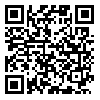BibTeX | RIS | EndNote | Medlars | ProCite | Reference Manager | RefWorks
Send citation to:
URL: http://tumj.tums.ac.ir/article-1-703-en.html
Background: To eradicate a problem such as drug abuse, we need thorough knowledge of the problem and its epidemiological aspects. In response to increasing ecstasy abuse among youth, as noted by the increase in related health issues at emergency clinics, we performed this epidemiologic study on ecstasy use in Tehran.
Methods: In this cross-sectional study, including 1,903 youth aged 15-25 years, at different coffee shops in Tehran, Iran, subjects filled out questionnaires to evaluate the prevalence of ecstasy use with regard to gender, age, family income, level of education, psychological state (Beck test), acute complications of ecstasy use, as well as manner and place of ecstasy use and reason for repeated ecstasy use. Information was gathered from September 2004 to January 2005, using simple nonprobable sampling.
Results: The prevalence of ecstasy abuse among our study population was 18.5%, which meaningfully correlated with gender (male), education level (undergraduate degree), family income (high), drug abuse and Beck test score (high). The mean age of ecstasy abusers was 21.3 years (SD: 2.65), which wasn't statistically different than the study population as a whole and the portion that did not use ecstasy. Tablet was the most common form of ecstasy usage (97.1%). In this study population, 91.4% had heard of the ecstasy name, and 83.7% were familiar with its use. The most common site of usage was in parties (85.7%) and in group forms (84%). Of all the users, 30% stated the reason for repeat ecstasy use was their friends' insistence, 38.8% expressed emotional need, 37.7% had no reason, whereas 6.6% felt a physical need and 1.7% repeatedly used ecstasy to prevent withdrawal symptoms
Conclusion: Some studies have reported that drug abusing friends are the basic cause of drug abuse. In this study, the ecstasy users admitted that the influence of friends and emotional need were the causes of their repeat use. Remarkably, these subjects report withdrawal symptoms with ecstasy use. Most importantly, families have to consider the relationships and emotional needs of their children. The statistical difference between Beck test scores between ecstasy users and the non-users placed them in two clinically different psychological groups. The ecstasy users were in groups that definitely needed psychological consultation and non-users were in the slightly depressed group. These psychological aspect of drug abuse expressed here is an alarm.
| Rights and permissions | |
 |
This work is licensed under a Creative Commons Attribution-NonCommercial 4.0 International License. |





